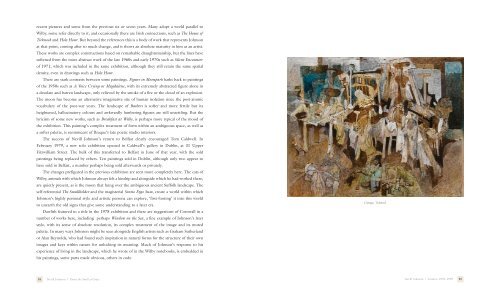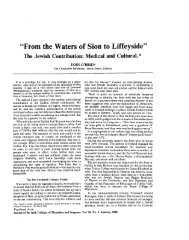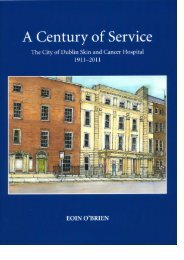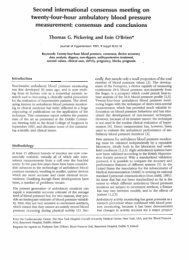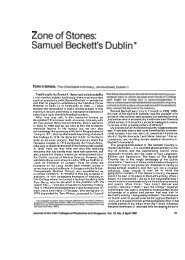Nevill Johnson: Paint the smell of grass - Eoin O'Brien
Nevill Johnson: Paint the smell of grass - Eoin O'Brien
Nevill Johnson: Paint the smell of grass - Eoin O'Brien
Create successful ePaper yourself
Turn your PDF publications into a flip-book with our unique Google optimized e-Paper software.
ecent pictures and some from <strong>the</strong> previous six or seven years. Many adopt a world parallel to<br />
Wilby, some refer directly to it, and occasionally <strong>the</strong>re are Irish connections, such as The House <strong>of</strong><br />
Ticknock and Holy Hour. But beyond <strong>the</strong> references this is a body <strong>of</strong> work that represents <strong>Johnson</strong><br />
at that point, coming after so much change, and it shows an absolute maturity in him as an artist.<br />
These works are complex constructions based on remarkable draughtsmanship, but <strong>the</strong> lines have<br />
s<strong>of</strong>tened from <strong>the</strong> more abstract work <strong>of</strong> <strong>the</strong> late 1960s and early 1970s such as Silent Encounter<br />
<strong>of</strong> 1971, which was included in <strong>the</strong> same exhibition, although <strong>the</strong>y still retain <strong>the</strong> same spatial<br />
density, even in drawings such as Holy Hour.<br />
There are stark contrasts between some paintings. Figure in Moonpark harks back to paintings<br />
<strong>of</strong> <strong>the</strong> 1950s such as A Voice Crying or Magdalene, with its extremely abstracted figure alone in<br />
a desolate and barren landscape, only relieved by <strong>the</strong> smoke <strong>of</strong> a fire or <strong>the</strong> cloud <strong>of</strong> an explosion.<br />
The moon has become an alternative imaginative site <strong>of</strong> human isolation since <strong>the</strong> post-atomic<br />
vocabulary <strong>of</strong> <strong>the</strong> post-war years. The landscape <strong>of</strong> Ba<strong>the</strong>rs is s<strong>of</strong>ter and more fertile but its<br />
heightened, hallucinatory colours and awkwardly lumbering figures are still unsettling. But <strong>the</strong><br />
lyricism <strong>of</strong> some new works, such as Breakfast at Wilby, is perhaps more typical <strong>of</strong> <strong>the</strong> mood <strong>of</strong><br />
<strong>the</strong> exhibition. This painting’s complex treatment <strong>of</strong> form within an ambiguous space, as well as<br />
a s<strong>of</strong>ter palette, is reminiscent <strong>of</strong> Braque’s late poetic studio interiors.<br />
The success <strong>of</strong> <strong>Nevill</strong> <strong>Johnson</strong>’s return to Belfast clearly encouraged Tom Caldwell. In<br />
February 1979, a new solo exhibition opened in Caldwell’s gallery in Dublin, at 31 Upper<br />
Fitzwilliam Street. The bulk <strong>of</strong> this transferred to Belfast in June <strong>of</strong> that year, with <strong>the</strong> sold<br />
paintings being replaced by o<strong>the</strong>rs. Ten paintings sold in Dublin, although only two appear to<br />
have sold in Belfast, a number perhaps being sold afterwards or privately.<br />
The changes prefigured in <strong>the</strong> previous exhibition are seen more completely here. The cats <strong>of</strong><br />
Wilby, animals with which <strong>Johnson</strong> always felt a kinship and alongside which he had worked <strong>the</strong>re,<br />
are quietly present, as is <strong>the</strong> moon that hung over <strong>the</strong> ambiguous ancient Suffolk landscape. The<br />
self-referential The Smallholder and <strong>the</strong> magisterial Sentio Ergo Sum, create a world within which<br />
<strong>Johnson</strong>’s highly personal style and artistic persona can explore, ‘first-footing’ it into this world<br />
to unearth <strong>the</strong> old signs that give some understanding to a later era.<br />
Dawlish featured in a title in <strong>the</strong> 1978 exhibition and <strong>the</strong>re are suggestions <strong>of</strong> Cornwall in a<br />
number <strong>of</strong> works here, including perhaps Window on <strong>the</strong> Sea, a fine example <strong>of</strong> <strong>Johnson</strong>’s later<br />
style, with its sense <strong>of</strong> absolute resolution, its complex treatment <strong>of</strong> <strong>the</strong> image and its muted<br />
palette. In many ways <strong>Johnson</strong> might be seen alongside English artists such as Graham Su<strong>the</strong>rland<br />
or Alan Reynolds, who had found such inspiration in natural forms for <strong>the</strong> structure <strong>of</strong> <strong>the</strong>ir own<br />
images and keys within nature for unlocking its meaning. Much <strong>of</strong> <strong>Johnson</strong>’s response to his<br />
experience <strong>of</strong> living in <strong>the</strong> landscape, which he wrote <strong>of</strong> in <strong>the</strong> Wilby notebooks, is embedded in<br />
his paintings, some parts made obvious, o<strong>the</strong>rs in code.<br />
84 <strong>Nevill</strong> <strong>Johnson</strong> l <strong>Paint</strong> <strong>the</strong> Smell <strong>of</strong> Grass<br />
Cottage, Tichnock<br />
<strong>Nevill</strong> <strong>Johnson</strong> l London 1978–1999 85


